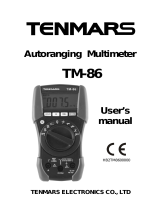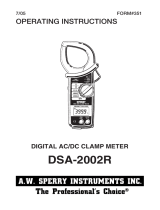
xiv___________________________________________________
Operating Precautions
___________________________________________________
NOTE Correct measurement may be impossible in the
presence of strong magnetic fields, such as near
transformers and high-current conductors, or in the
presence of strong electromagnetic fields such as
near radio transmitters.
To avoid corrosion from battery leakage, remove the
batteries from the instrument if it is to be stored for
a long time.
Hall elements are used in the current detection
portion of the clamp on AC/DC HiTester. As there
are two types of drifts in the Hall elements, drift
depending on time and drift depending on the
surrounding temperature, take note when conducting
continuous measurements.
The Hall elements lack uniformity, and it is
impossible to determine the amount of variation
which depends on time and the temperature. When
conducting continuous measurement or in an
environment where there are huge temperature
variations, it is recommended that the variation at
point 0 when nothing has been inputted should be
first noted. The variation at point 0 is the direct
current component.This does not affect the AC
mode.
Due to the offset peculiar to elements from a hall
effect, the display may sometimes not show 0
immediately after it is turned on, but this is not a
malfunction. The count remaining has an
instrumental difference of 0 to a few tens A.
When using in DC or AC/DC mode, press the
0ADJ/RESET key each time the power is turned
on to carry out auto zero adjustment.
When 0 is displayed after zero adjustment, the
measurement can be performed without the
interference of the count remaining immediately
after the power is turned on.























